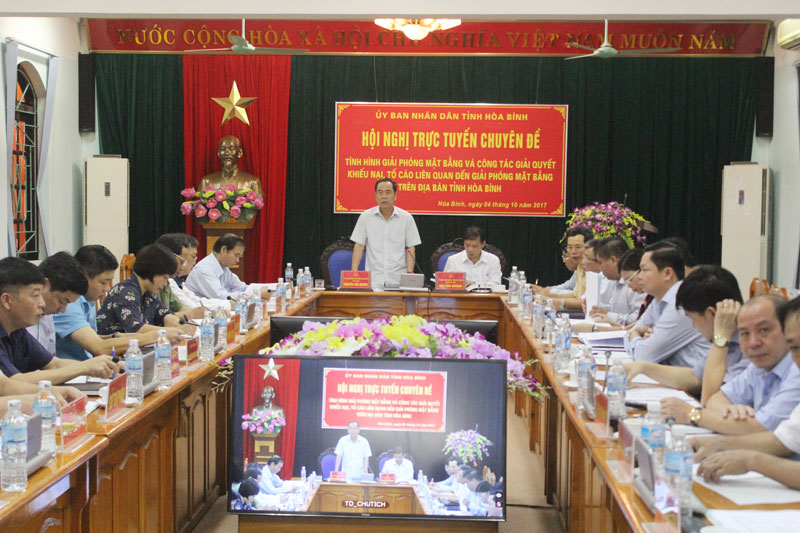
(HBO) – Vice Secretary of the Party Committee and Chairman of the People’s Committee of Hoa Binh province Nguyen Van Quang has chaired a teleconference on site clearance and settlement of complaints relating to land seizure, site clearance and resettlement support in the locality.
Chairman
of the provincial People’s Committee Nguyen Van Quang speaks at the conference.
Since 2014, Hoa Binh province has finished
compensation and site clearance for 289 projects covering 549.4ha of land.
About 818.66 billion VND (over 36 million USD) has been spent on compensating
and assisting 12,099 households whose land revoked to resettle. Site clearance
is being conducted for about 60 projects across the province, expecting to
withdraw around 310.6ha of land.
Provincial authorities have directed sectors and
local administrations to handle obstacles in compensating owners of seized land
and site clearance in key and complicated projects such as Hoa Lac – Hoa Binh
road and Road No. 21 traversing Kim Boi and Lac Thuy districts. However, the
progress of site clearance for some projects remains sluggish.
Since 2014, the boards for citizen reception at
all levels have met 1,677 delegations with 2,745 people who came to submit
complaints, denunciations and opinions about 1,898 cases, 1,229 cases of which
related to land management, compensation for seized land, and support during
land seizure. The boards handled 1,953 petitions of all kinds, including 1,444
ones relevant to land and site clearance.
Concluding the meeting, Chairman of the
provincial People’s Committee Nguyen Van Quang stressed that the smooth
implementation of site clearance will help reduce complaints and denunciations
while attracting investment and boosting socio-economic development.
To solve bottlenecks and shortcomings in site
clearance and complaint settlement, it is necessary to improve the leadership
capacity of Party committees and administrations and bring into play the role
of organisations in raising local residents’ awareness of law observance.
Quang underlined the need to promote advisory
bodies’ capacity to serve the issuance of compensation and resettlement support
regulations, enhance coordination in site clearance among authorized agencies
and localities, and thoroughly deal with related problems, especially in key
projects.
He also asked for transparent land planning,
land seizure and compensation, along with examination and strict punishment of
violators or persons inciting others to violate regulations./.
The Standing Board of the Hoa Binh provincial Party Committee met on March 18 to review and guide major investment projects aimed at boosting local socio-economic development.
The air is thick with the hum of drills and the clatter of machinery as the Hoa Binh – Moc Chau expressway takes shape amid the rugged terrain. Welding sparks illuminate the faces of workers, and concrete mixers churn relentlessly, laying fresh pavement on the newly-carved road. The construction site buzzes with a palpable sense of urgency, particularly in Hoa Binh province where the expressway's future is being forged.
The northern province of Hoa Binh, with over 467,000 hectares of natural forest and more than 100,000 hectares of production forest, holds significant potential for carbon credit market development.
Replacing substandard houses with more sturdy ones by June 30 is the direction given by Nguyen Phi Long, alternate member of the Party Central Committee and Secretary of the Hoa Binh provincial Party Committee, at a meeting held in early March by the provincial Steering Committee for the programme to eliminate temporary and dilapidated houses for the needy.
Recognising digital transformation as an inevitable trend, authorities and agencies in Hoa Binh have made great efforts in the work by focusing on three core pillars - digital government, digital society, and digital economy, resulting in enhanced competitiveness, improved investment climate, and ensured economic and social welfare.
In recent years, Da Bac district has improved administrative reform with a one-stop shop mechanism, streamlined inter-agency procedures, and a shift to digital platforms. These efforts have enhanced public service efficiency and contributed to local socio-economic development.



